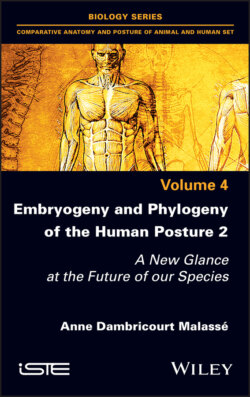Читать книгу Embryogeny and Phylogeny of the Human Posture 2 - Anne Dambricourt Malasse - Страница 2
Table of Contents
Оглавление1 Cover
4 1 The 20th Century. A New Science: Human Paleontology 1.1. Introduction 1.2. Human paleontology, a nascent science 1.3. Presuppositions
5 2 Asia, The Cradle of Humanity 2.1. Teilhard de Chardin, a destiny from Piltdown to the Muséum 2.2. The primate ancestor of the human lineage in Montauban 2.3. Teilhard de Chardin sets out the main phylogenetic principles 2.4. Human paleontology is a branch of planetology 2.5. China, the promise of very ancient mammalian and human species 2.6. Peking Man: a small brain but well-cut tools 2.7. The first study of the internal basis of a Hominidae fossil 2.8. A new paradigm: telencephalization
6 3 South and East Africa: The New Cradle 3.1. Gracile, robust Australopithecines and Humans 3.2. “A systematic research plan for Early Man in South Africa” 3.3. The Princeton synthetic theory (neo-Darwinism) and the Sorbonne replica (neo-Lamarckism) 3.4. Hominization, “background orthogenesis” 3.5. First synthesis: Man and the third axis of cosmic evolution of increasing complexity–consciousness
7 4 The Body, Arboricolism and Adaptation: The Years 1950–1980 4.1. Under the brain, a body 4.2. Hominization of the skull and posture, French schools
8 5 The Embryonic and Phylogenetic Origins of Human Posture 5.1. A reversal of perspectives 5.2. Evidence of craniofacial contraction 5.3. The embryonic origin of the sphenoidal angle and cranio-spinal straightening 5.4. Craniofacial contraction 5.5. Conclusion: developmental heterochronies and dynamic trajectories
9 6 Fossil Species: From the First Primates to the First Hominids 6.1. Mandibles, witnesses of straightening 6.2. The great ape-Hominidae transition: an acceleration in the complexity of embryogenesis 6.3. Axial straightening, cranio-palatal balance and occlusion of Hominids sensu stricto
10 7 Homo and Sapiens Embryogenesis 7.1. Fossil taxa of the genus Homo 7.2. Fossil mandibles from Homo sapiens 7.3. The Neanderthal is not a Sapiens 7.4. The cerebellum position of extinct Homo species 7.5. What is the relationship between the Neanderthals and the Sapiens? 7.6. The collapse of a paradigm: Man was present in Asia before the end of the Tertiary Era 7.7. Gracilization, cerebellization, anticipation and emotion 7.8. The new Rubicon: brain stem verticality and cerebellar instability 7.9. New sciences for an emerging evolutionary problem 7.10. The future of Sapiens, a dialog between the cerebellum and the brain?
11 Conclusion
12 References
13 Index
